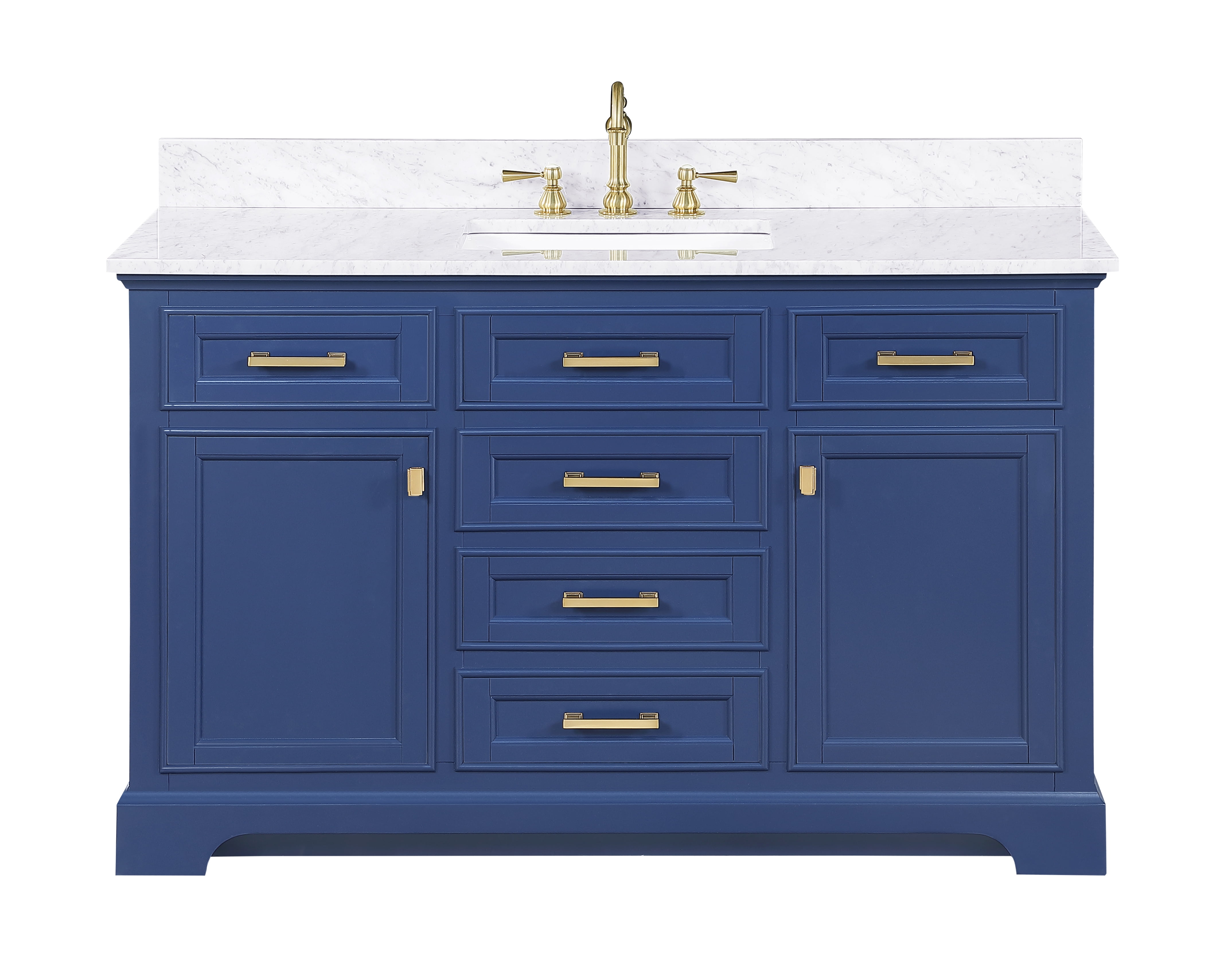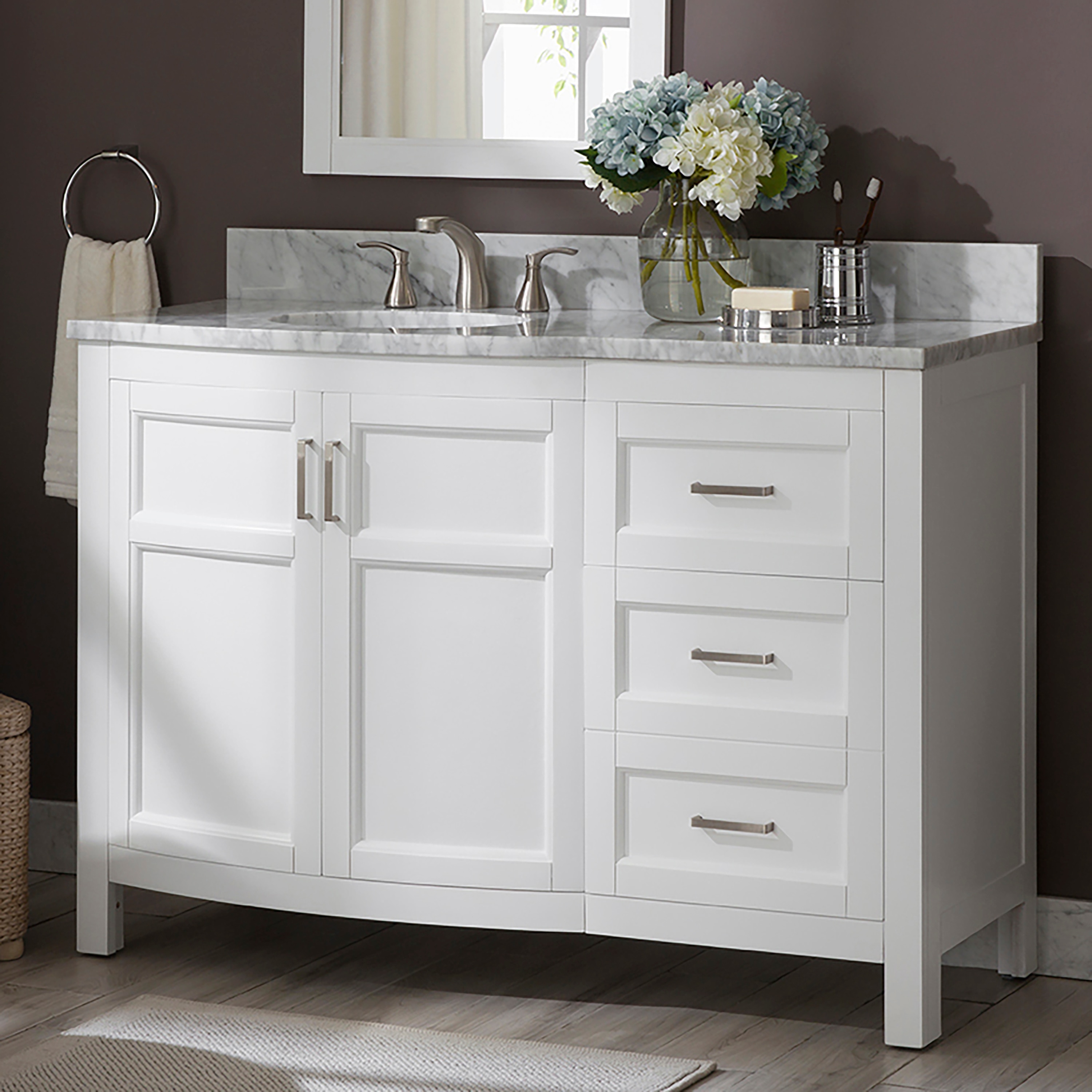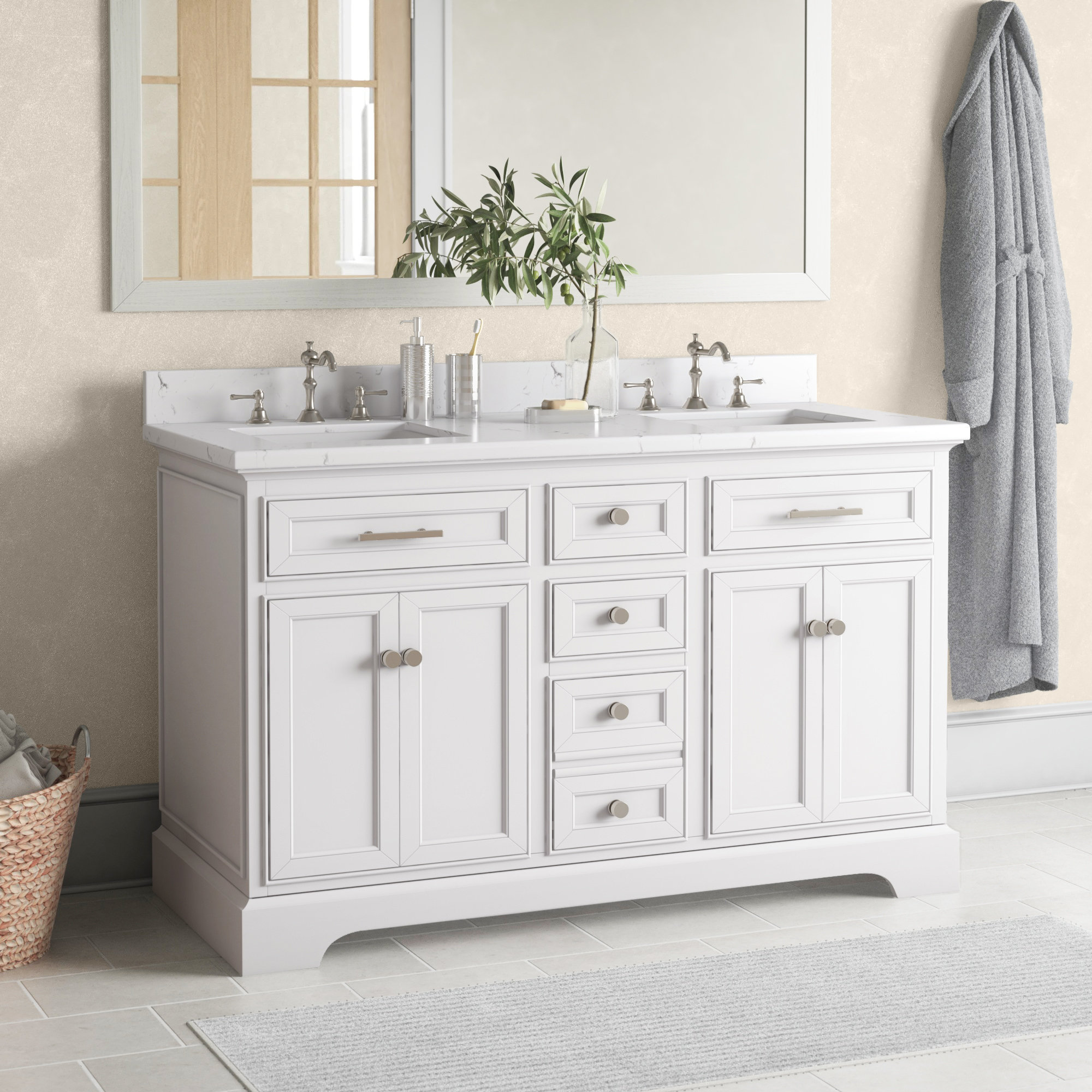Understanding the 54″ Wide Bathroom Vanity

A 54″ wide bathroom vanity is a popular choice for larger bathrooms, offering ample space for storage and functionality. This size is ideal for families or individuals who require more counter space and storage capacity.
Features of a 54″ Wide Bathroom Vanity
A 54″ wide bathroom vanity typically features a spacious countertop, multiple drawers and cabinets, and a sink. The countertop can be made from various materials, including granite, marble, quartz, or laminate. The cabinets are often constructed from wood or laminate, offering durability and resistance to moisture. The sink can be a single-bowl or double-bowl design, depending on the specific vanity model.
Benefits of Choosing a 54″ Wide Vanity, 54 wide bathroom vanity
A 54″ wide vanity provides several advantages over smaller vanities. It offers a generous amount of counter space, allowing for easy access to toiletries, cosmetics, and other bathroom essentials. The ample storage space in the drawers and cabinets helps keep the bathroom organized and clutter-free. This extra storage capacity is particularly beneficial for families or individuals with a large collection of bathroom supplies.
Materials Used in 54″ Wide Bathroom Vanities
- Wood: Wood vanities are a popular choice due to their natural beauty and durability. They are available in various wood species, each with its unique grain pattern and color. Common wood choices include oak, maple, cherry, and walnut.
- Laminate: Laminate vanities are a cost-effective alternative to wood vanities. They are made from layers of resin-impregnated paper, offering durability and moisture resistance. Laminate vanities are available in a wide range of colors and patterns, mimicking the look of natural stone or wood.
- Stone: Stone vanities, such as granite or marble, offer a luxurious and elegant look. They are durable and heat-resistant, making them ideal for bathrooms with high traffic. However, stone vanities are more expensive than wood or laminate vanities.
Choosing the Right 54″ Wide Bathroom Vanity: 54 Wide Bathroom Vanity

A 54″ wide bathroom vanity offers ample storage and counter space, perfect for larger bathrooms or those who prefer a more spacious feel. Selecting the right vanity involves considering various factors, including style, budget, and installation requirements.
Style
The style of your vanity should complement the overall design aesthetic of your bathroom. Popular styles include:
- Traditional: Characterized by ornate details, such as carved wood, decorative hardware, and classic silhouettes. Traditional vanities often feature a warm color palette and a timeless appeal.
- Modern: Modern vanities prioritize clean lines, sleek surfaces, and minimalist design elements. They often feature geometric shapes, metallic accents, and neutral color palettes.
- Contemporary: Contemporary vanities share similarities with modern styles but embrace a more experimental and eclectic approach. They often feature bold colors, unique materials, and unexpected design details.
- Farmhouse: Farmhouse vanities exude a rustic charm with distressed wood finishes, open shelving, and simple hardware. They often feature a warm and inviting aesthetic, reminiscent of a country cottage.
Budget
Bathroom vanities come in a wide range of prices, depending on materials, construction, and features. Setting a realistic budget will help you narrow down your options and avoid overspending.
- Entry-level: Entry-level vanities typically range from $300 to $1,000 and are made from materials like laminate or MDF. They offer basic functionality and a simple design.
- Mid-range: Mid-range vanities typically cost between $1,000 and $3,000 and are often made from solid wood or engineered wood with a more refined finish. They offer more storage options and a wider variety of styles.
- High-end: High-end vanities can cost upwards of $3,000 and are typically made from premium materials like solid wood, natural stone, and high-quality hardware. They feature intricate craftsmanship, unique design elements, and exceptional durability.
Installation Requirements
Before purchasing a vanity, it’s crucial to consider the installation requirements.
- Space: Ensure you have enough space to accommodate the vanity’s width, depth, and height. Consider the clearance required for doors, drawers, and plumbing.
- Plumbing: Check the location of your existing plumbing and ensure it’s compatible with the vanity’s sink and drain configuration. You may need to adjust plumbing lines or hire a professional plumber.
- Electrical: If your vanity includes lighting or other electrical components, ensure you have adequate wiring and outlets available.
Sink Type
The sink type is an integral part of your vanity’s functionality and design.
- Undermount: Undermount sinks are seamlessly integrated into the countertop, creating a clean and modern look. They are easier to clean and provide ample counter space.
- Top-mount: Top-mount sinks sit on top of the countertop, offering a more traditional and budget-friendly option. They are typically easier to install but can limit counter space.
- Vessel: Vessel sinks are freestanding and sit on top of the countertop, adding a decorative element to the vanity. They are often made from ceramic, glass, or stone and offer a unique visual appeal.
Countertop Material
The countertop material plays a significant role in the vanity’s durability, style, and overall aesthetic.
- Granite: Granite is a natural stone known for its durability, scratch resistance, and unique patterns. It is a popular choice for high-end vanities and can withstand heavy use.
- Marble: Marble is another natural stone known for its elegance and veining patterns. However, it is more porous and susceptible to staining than granite.
- Quartz: Quartz is an engineered stone that combines natural quartz with resin, creating a durable and stain-resistant surface. It is available in a wide range of colors and patterns.
- Laminate: Laminate is a cost-effective and durable option that mimics the look of natural stone. It is available in various colors and patterns and is easy to clean.
Installing a 54″ Wide Bathroom Vanity

Installing a 54″ wide bathroom vanity is a DIY project that can be tackled by anyone with basic plumbing and carpentry skills. The process involves several steps, from preparing the space to connecting the plumbing fixtures and ensuring proper drainage. With the right tools and materials, you can easily install a new vanity and give your bathroom a fresh, updated look.
Preparing the Space
Before you start installing the vanity, it’s essential to prepare the space properly. This includes removing the old vanity, clearing out the area, and ensuring the floor is level.
- Remove the old vanity: Disconnect the water supply lines and drain pipes, and carefully remove the old vanity from the wall.
- Clear the area: Remove any obstacles or clutter from the space where you’ll be installing the new vanity.
- Level the floor: Use a level to ensure the floor is level and even. If necessary, adjust the floor with a leveling compound or shims.
Installing the Vanity
Once the space is prepared, you can start installing the vanity. This involves attaching the vanity to the wall, connecting the water supply lines and drain pipes, and ensuring proper drainage.
- Attach the vanity to the wall: Use a stud finder to locate wall studs, and attach the vanity to the wall using screws or brackets. Ensure the vanity is level and secure.
- Connect the water supply lines: Connect the water supply lines to the vanity’s faucets, ensuring the connections are tight and secure.
- Connect the drain pipe: Connect the drain pipe to the vanity’s drain, ensuring the connection is tight and secure.
Ensuring Proper Drainage
Proper drainage is crucial for a functional bathroom vanity. You need to ensure the drain pipe is properly connected and the trap is installed correctly to prevent water from backing up.
- Install the trap: Install a P-trap under the vanity to prevent sewer gases from entering the bathroom. Ensure the trap is properly sealed and connected to the drain pipe.
- Check for leaks: After connecting the water supply lines and drain pipe, check for leaks.
Finishing Touches
Once the vanity is installed and the plumbing is connected, you can add the finishing touches. This includes installing the sink, mirror, and any other accessories.
- Install the sink: Install the sink on top of the vanity, ensuring it is properly aligned and secured.
- Install the mirror: Install the mirror above the vanity, ensuring it is level and securely attached to the wall.
- Install accessories: Install any other accessories, such as towel bars, shelves, or lighting fixtures.
